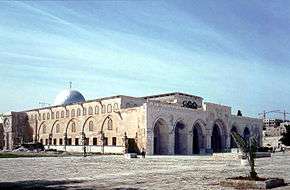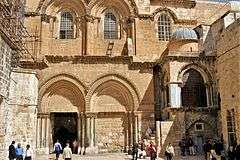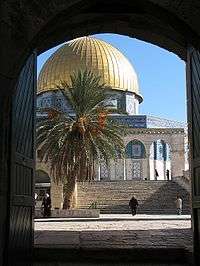Siege of Jerusalem (636–637)
| Siege of Jerusalem (637) | |||||||||
|---|---|---|---|---|---|---|---|---|---|
| Part of the Muslim conquest of Syria (Arab–Byzantine Wars) | |||||||||
 The Al-Aqsa Mosque, Jerusalem, is one of the most sacred sites for Muslims. | |||||||||
| |||||||||
| Belligerents | |||||||||
|
|
| ||||||||
| Commanders and leaders | |||||||||
|
Abu Ubaidah ibn al-Jarrah Khalid ibn al-Walid Yazid ibn Abu Sufyan Amr ibn al-A'as Sharjeel ibn Hassana | Patriarch Sophronius | ||||||||
| Strength | |||||||||
| ~20,000[1] | Unknown | ||||||||
The Siege of Jerusalem was part of a military conflict which took place in the year 637 between the Byzantine Empire and the Rashidun Caliphate. It began when the Rashidun army, under the command of Abu Ubaidah, besieged Jerusalem in November 636. After six months, the Patriarch Sophronius agreed to surrender, on condition that he submit only to the Rashidun caliph. In April 637, Caliph Umar traveled to Jerusalem in person to receive the submission of the city. The Patriarch thus surrendered to him.
The Muslim conquest of the city solidified the Arab control over Palestine, control which would not again be threatened until the First Crusade in the late 11th century. Thus, it came to be regarded as a holy site by Islam, as well as by Christianity and Judaism. This stabilized control of Palestina Prima. In 613, the Jewish revolt against the Byzantine Heraclius culminated with the conquest of Jerusalem in 614 by Persian and Jewish forces and establishment of Jewish autonomy. The revolt ended with the departure of the Persians and an eventual massacre of the Jews in 629 by the Byzantines ending 15 years of Jewish autonomy.
Following the Muslim conquest of Jerusalem, Jews were once again allowed to live and practice their religion in Jerusalem, 8 years after their massacre by the Byzantines and nearly 500 years after their expulsion from Judea by the Roman Empire.
Prelude
Jerusalem was an important city of the Byzantine province of Palestina Prima. Just 23 years prior to the Muslim conquest, in 614, it fell to an invading Sassanid army under Shahrbaraz during the last of the Byzantine-Sassanid Wars. The Persians looted the city, and are said to have massacred its 90,000 Christian inhabitants.[2] As part of the looting, the Church of the Holy Sepulchre was destroyed and the True Cross captured and taken to Ctesiphon as a battle-captured holy relic. The Cross was later returned to Jerusalem by Emperor Heraclius after his final victory against the Persians in 628. It was believed that the Jews, who were persecuted in their Roman-controlled homeland, had aided the Persians.[3]
After the death of Muhammad in 632, Muslim leadership passed to Caliph Abu Bakr following a series of campaigns known as the Ridda Wars. Once Bakr's sovereignty over Arabia had been secured, he initiated a war of conquest in the east by invading Iraq, then a province of the Sassanid Persian Empire; while on the western front, his armies invaded the Byzantine Empire.[4]
In 634, Abu Bakr died and was succeeded by Umar, who continued his own war of conquest.[5] In May 636, Emperor Heraclius launched a major expedition to regain the lost territory, but his army was defeated decisively at the Battle of Yarmouk in August 636. Thereafter, Abu Ubaidah, the Muslim commander-in-chief of the Rashidun army in Syria, held a council of war in early October 636 to discuss future plans. Opinions of objectives varied between the coastal city of Caesarea and Jerusalem. Abu Ubaidah could see the importance of both these cities, which had resisted all Muslim attempts at capture. Unable to decide on the matter, he wrote to Caliph Umar for instructions. In his reply, the caliph ordered them to capture the latter. Accordingly, Abu Ubaidah marched towards Jerusalem from Jabiya, with Khalid ibn Walid and his mobile guard leading the advance. The Muslims arrived at Jerusalem around early November, and the Byzantine garrison withdrew into the fortified city.[1]
Siege
Jerusalem had been well-fortified after Heraclius recaptured it from the Persians.[6] After the Byzantine defeat at Yarmouk, the Patriarch of Jerusalem Sophronius repaired its defenses.[7] The Muslims had so far not attempted any siege of the city. However, since 634, Saracen forces had the potential to threaten all routes to the city. Although it was not encircled, it had been in a state of siege since the Muslims captured the neighboring forts of Pella and Bosra. After the Battle of Yarmouk, the city was severed from the rest of Syria, and was presumably being prepared for a siege that seemed inevitable.[6] When the Muslim army reached Jericho, Sophronius collected all the holy relics including the True Cross, and secretly sent them to the coast, to be taken to Constantinople.[7] The Muslim troops besieged the city some time in November 636. Instead of relentless assaults on the city,a[›] they decided to press on with the siege until the Byzantines ran short of supplies and a bloodless surrender could be negotiated.[8]
Although details of the siege were not recorded,b[›] it appeared to be bloodless.[9] The Byzantine garrison could not expect any help from the humbled regime of Heraclius. After a siege of four months, Sophronius offered to surrender the city and pay a jizya (tribute), on condition that the caliph came to Jerusalem to sign the pact and accept the surrender.[10] It is said that when Sophronius's terms became known to the Muslims, Shurahbil ibn Hassana, one of the Muslim commanders, suggested that instead of waiting for the caliph to come all the way from Madinah, Khalid ibn Walid should be sent forward as the caliph, as he was very similar in appearance to Umar.[11] The subterfuge did not work. Possibly, Khalid was too famous in Syria, or there may have been Christian Arabs in the city who had visited Madinah and had seen both Umar and Khalid, remembering the differences. Consequently, the Patriarch of Jerusalem refused to negotiate. When Khalid reported the failure of this mission, Abu Ubaidah wrote to caliph Umar about the situation, and invited him to come to Jerusalem to accept the surrender of the city.[12]
Surrender

In early April 637, Umar arrived in Palestine and went first to Jabiya,[13] where he was received by Abu Ubaidah, Khalid, and Yazid, who had traveled with an escort to receive him. Amr was left as commander of the besieging Muslim army.[14]
Upon Umar's arrival in Jerusalem, a pact known as The Umariyya Covenant was composed. It surrendered the city and gave guarantees of civil and religious liberty to Christians in exchange for jizya. It was signed by caliph Umar on behalf of the Muslims, and witnessed by Khalid, Amr, Abdur Rahman bin Awf, and Muawiyah. In late April 637, Jerusalem was officially surrendered to the caliph.[15] For the first time, after almost 500 years of oppressive Roman rule, Jews were once again allowed to live and worship inside Jerusalem.[16]
It has been recorded in the annals of Muslim chronicles, that at the time of the Zuhr prayers, Sophronius invited Umar to pray in the rebuilt Church of the Holy Sepulchre. Umar declined, fearing that accepting the invitation might endanger the church's status as a Christian temple, and that Muslims might break the treaty and turn the temple into a mosque.[8] After staying for ten days in Jerusalem, the caliph returned to Medina.[17]
Aftermath

Following the Caliph's instructions, Yazid proceeded to Caesarea, and once again laid siege to the port city. Amr and Shurahbil marched to complete the occupation of Palestine, a task that was completed by the end of the year. Caesarea, however, could not be taken until 640, when at last, the garrison surrendered to Muawiyah I, then a governor of Syria. With an army of 17,000 men, Abu Ubaidah and Khalid set off from Jerusalem to conquer all of northern Syria. This ended with the conquest of Antioch in late 637.[18] In 639, the Muslims invaded and conquered Egypt.
During his stay in Jerusalem, Umar was led by Sophronius to various holy sites, including the Temple Mount. Seeing the poor state of where the Temple once stood, Umar ordered the area cleared of refuse and debris before having a wooden mosque built on the site.[19] The earliest account of such a structure is given by the Gallic bishop Arculf, who visited Jerusalem between 679 and 682, and describes a very primitive house of prayer able to accommodate up to 3,000 worshippers, constructed of wooden beams and boards over pre-existing ruins.[20]
More than half a century after the capture of Jerusalem, in 691, the Umayyad caliph Abd al-Malik commissioned the construction of the Dome of the Rock over a large outcropping of bedrock on the Temple Mount. The 10th-century historian al-Muqaddasi wrote that Abd al-Malik built the shrine in order to compete in grandeur with the city's Christian churches. Whatever the intention, the impressive splendor and scale of the shrine is seen as having helped significantly in solidifying the attachment of Jerusalem to the early Muslim faith.[19]
Over the next 400 years, the city's prominence diminished as Saracen powers in the region jockeyed for control. Jerusalem remained under Muslim rule until it was captured by Crusaders in 1099 during the First Crusade.
Notes
^ a: The Muslims are said to have lost 4,000 men in the Battle of Yarmouk fought just two months before the siege.
^ b: Muslim historians differ in the year of the siege; while Tabari says it was 636, al-Baladhuri placed its date of surrender in 638 (Futuh II.XI or p. 139; p. 214 in Hitti translation). Agha I. Akram believes 636–637 to be the most likely date.
References
Citations
- 1 2 Akram 2004, p. 431.
- ↑ Greatrex & Lieu 2002, p. 198.
- ↑ Haldon 1997, p. 46.
- ↑ Nicolle 1994, pp. 12–14.
- ↑ Lewis 2002, p. 65.
- 1 2 Gil 1997, p. 51.
- 1 2 Runciman 1987, p. 17.
- 1 2 Gibbon 1862, Volume 6, p. 321.
- ↑ Akram 2004, p. 432.
- ↑ Benvenisti 1998, p. 14.
- ↑ al-Waqidi. Futuh al-Sham, Volume 1, p. 162; Imad ad-Din al-Isfahani. al-Fath al-Qussi fi-l-Fath al-Qudsi, Volume 15, pp. 12–56.
- ↑ Akram 2004, p. 433.
- ↑ Gil 1997, p. 52.
- ↑ Akram 2004, p. 434.
- ↑ Gil 1997, p. 54.
- ↑ Gil 1997, pp. 70–71.
- ↑ al-Waqidi. Futuh al-Sham, Volume 1, p. 169.
- ↑ Akram 2004, p. 438.
- 1 2 Hoppe 2000, p. 15.
- ↑ Elad 1999, p. 33.
Sources
- Akram, Agha Ibrahim (2004). The Sword of Allah: Khalid bin al-Waleed – His Life and Campaigns. Oxford, United Kingdom: Oxford University Press. ISBN 0-19-597714-9.
- Benvenisti, Meron (1998). City of Stone: The Hidden History of Jerusalem. Berkeley and Los Angeles, California: University of California Press. ISBN 0-520-20768-8.
- Elad, Amikam (1999) [1995]. Medieval Jerusalem and Islamic Worship: Holy Places, Ceremonies, Pilgrimage. Leiden, The Netherlands and New York, New York: Brill Publishers. ISBN 90-04-10010-5.
- Gibbon, Edward (1862). The History of the Decline and Fall of the Roman Empire, Volume 6. J. D. Morris Publishers.
- Gil, Moshe (1997). A History of Palestine, 634–1099. Cambridge, United Kingdom: Cambridge University Press. ISBN 0-521-59984-9.
- Greatrex, Geoffrey; Lieu, Samuel N. C. (2002). The Roman Eastern Frontier and the Persian Wars (Part II, 363–630 AD). New York, New York and London, United Kingdom: Routledge (Taylor & Francis). ISBN 0-415-14687-9.
- Haldon, John F. (1997) [1990]. Byzantium in the Seventh Century: The Transformation of a Culture. Cambridge, United Kingdom: Cambridge University Press. ISBN 978-0-521-31917-1.
- Hoppe, Leslie J. (2000). The Holy City: Jerusalem in the Theology of the Old Testament. Collegeville, Minnesota: The Liturgical Press. ISBN 0-8146-5081-3.
- Lewis, Bernard (2002) [1993]. The Arabs in History. Oxford, United Kingdom: Oxford University Press. ISBN 0-19-280310-7.
- Nicolle, David (1994). Yarmuk 636 A.D.: The Muslim Conquest of Syria. Oxford, United Kingdom: Osprey Publishing Limited. ISBN 1-85532-414-8.
- Runciman, Steven (1987) [1951]. A History of the Crusades - Volume 1: The First Crusade and the Foundation of the Kingdom of Jerusalem. Cambridge, United Kingdom: Cambridge University Press. ISBN 978-0-521-34770-9.
External links
- Jerusalem and Umar ibn al-Khattab, Lost Islamic History
Coordinates: 31°47′00″N 35°13′00″E / 31.7833°N 35.2167°E